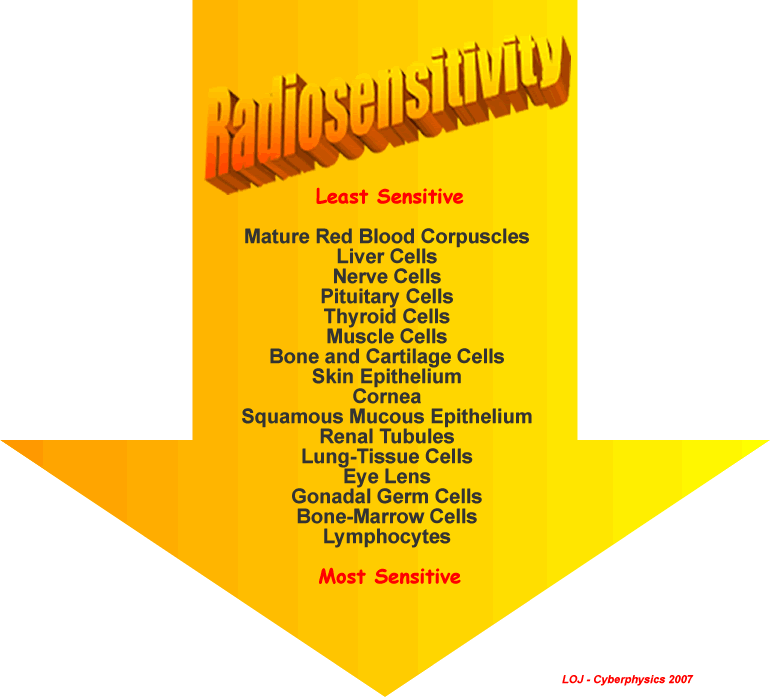|
How does the size
dose effect outcome? The bigger the dose, the more severe the effects.
| 0-150 rem |
- none to minimal
symptoms. Perhaps long-term effects many years later. |
| 150-400 rem |
- moderate
to severe illness due to hematopoietic (Haematopoietic tissue
is where blood
and blood cells are formed - like in the kidneys) derangement.
|
400-800 rem |
- severe illness.
|
| Above 800 rem |
- 100% fatal,
even with best available treatment. |
Partial body
exposure.
Effects depend on
particular tissue or organ exposed, but significant acute changes are
usually seen only after a fairly high radiation dose (>1000 rem).
Long-Term Effects of Exposure to Ionizing Radiation
 General characteristics: Usually occur many years after acute
or chronic radiation exposure. General characteristics: Usually occur many years after acute
or chronic radiation exposure.
 Biologic Effects of Ionizing Radiation: Occur
with much lower doses and dose-rates: insufficient to cause acute somatic
effects. Biologic Effects of Ionizing Radiation: Occur
with much lower doses and dose-rates: insufficient to cause acute somatic
effects.
Probably related
to irreparable damage to genetic material in cells which are capable
of continued cell division.
Radiation Carcinogenesis in Humans
Genetic and proliferative
alterations of cells require years to many lifetimes to develop.
 Tumor
development: Ionizing radiation in large amounts is an effective
carcinogenic agent. Tumor
development: Ionizing radiation in large amounts is an effective
carcinogenic agent.
 Sterility:
Temporary sterility can be induced at exposure levels of approximately
150 rem. Females are more often permanently affected than males. Sterility:
Temporary sterility can be induced at exposure levels of approximately
150 rem. Females are more often permanently affected than males.
 Cataracts:
Due to the high sensitivity of the lens of the eye, opaque areas
of the lens develop after exposure of 200-600 rem. Cataracts:
Due to the high sensitivity of the lens of the eye, opaque areas
of the lens develop after exposure of 200-600 rem.
 Life-shortening:
The aging process is increased. Nutrition to the cell appears
to be impaired. The total cell number is decreased and there
is a modification of the composition of cellular material. Life-shortening:
The aging process is increased. Nutrition to the cell appears
to be impaired. The total cell number is decreased and there
is a modification of the composition of cellular material.
 Fetal
damage: The fetus is highly radiosensitive due to the rapid
division of cells. No measurable fetal damage has been seen
at exposures less than one rem. Fetal
damage: The fetus is highly radiosensitive due to the rapid
division of cells. No measurable fetal damage has been seen
at exposures less than one rem.
 Chromosomal
damage: Detection of chromosomal damage requires many generations. Chromosomal
damage: Detection of chromosomal damage requires many generations.
Law of Bergonie and Tribondeau
 Radiation sensitivity
of cells generally varies directly with the rate of proliferation and
the number of future divisions, and inversely with the degree of morphological
and functional differentiation. Radiation sensitivity
of cells generally varies directly with the rate of proliferation and
the number of future divisions, and inversely with the degree of morphological
and functional differentiation.
(in other words
the faster the damaged cells divide the worse the problem if they have
been genetically altered. Also if they only come in one type and are
specific for one job to do in the body their alteration will have a
worse effect).
Factors
that Influence the Severity of Absorbed Dose
Internal Radiation
Amount
of Radioactivity
 Radioisotope Radioisotope
 Nature
or type of the emission Nature
or type of the emission
 Critical
Organ Critical
Organ
 Physical
half-life Physical
half-life
 Biological
half-life Biological
half-life
 Age, weight,
sex Age, weight,
sex
External Radiation
 Amount
of Radioactivity Amount
of Radioactivity
 Nature
or type of the emission Nature
or type of the emission
 Radiation
Energy Radiation
Energy
 Time Time
 Distance Distance
 Shielding Shielding
 Age, weight,
sex Age, weight,
sex
 Area of
the Body Exposed Area of
the Body Exposed
|